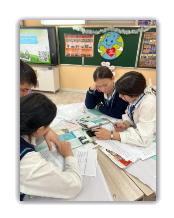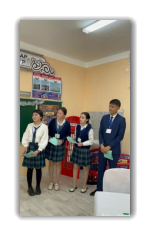Rationale for the Research Topic in Action
A special feature of the teaching profession is the need for constant learning and improvement of one's practice. School-based “Action research” is an approach through which practitioners discuss and solve school problem [«Teacher's Guide» p.237]. It is the” Action research “approach that allows a teacher to analyze his own practice and make changes that will ensure professional growth and achievement of planned results. While still in the first stage of the course, at the stage of preliminary planning for action research, I decided to conduct an experiment in the Training course for teachers. There are 12 learners in the group. Having worked in such kinds of groups, I noted that the majority of learners in the class are active in lessons, express their opinions, and enjoy participating in various extracurricular activities. Lessons in the classroom are interesting, the learners are happy to take part in various experiments. But after teaching several lessons, I noticed that the performance of the class had changed.

Previously inquisitive and active in the lesson, they “calmed down” and became “comfortable” passive listeners. To figure out what the reason was, I turned to a school psychologist and found out that the age of 14–15 years belongs to older adolescence. The main need of this age is the need to communicate with peers. Communication is knowing yourself through others, searching for yourself, paying attention to your inner life, and self-affirmation of the individual.
Since communication prevails, there is a colossal decrease in learning motivation. Having discussed our observations with colleagues, we came to the conclusion that such a decrease in learning motivation during the transition to grades 9–10 occurs in almost every grade. Despite the changes that had taken place, I still decided not to change the class to conduct research in action, but after studying the situation more deeply, try to change it.
Students working together in groups promotes mental development, learning, and communication skills, which encourages students to actively participate in their own learning. In a traditional lesson, the main figure is the teacher. In a passive class, the teacher talks, asks questions, moves around the room, writes on the board to instruct the class, explains, demonstrates, and demands silence. In this case, students are passive participants in the learning process: they take notes from the teacher’s dictation or from the board, listen calmly, and sit facing the teacher.
With such seemingly “well-being,” we do not achieve results. Even if a student acquires a good stock of knowledge, he is not always able to apply it in non-standard situations due to lack of experience [«Teacher's Guide» p.345]. Thus, the use of group work as a form of organizing learning changes the role of not only students, but also the teacher in the lesson. The teacher turns from a subject of knowledge into an experienced mentor who guides, fills and supports the learning process.
Training at the first stage of the course showed the effectiveness of working using a group form. Working in groups, we constantly found ourselves in different conditions, the composition of the groups changed, participated in various activities, exchanged opinions, answered questions and formulated them ourselves, researched and found solutions to problems. Thus, they became active participants in the learning process.
During the first stage of the course, my view on the role of the student and teacher in the learning process changed. According to the constructivist theory, the development of students’ thinking occurs in the context of the interaction of existing knowledge with new knowledge, or with knowledge obtained from different sources. Consequently, the traditional approach to teaching, where the teacher is practically the only source of information, cannot be effective.
The student, not the teacher, should be the key figure in the learning process. All actions of the teacher should be aimed at creating an environment in which the student can realize his educational needs.

Therefore, when developing the study, I needed not only to apply a group form of work, but to change the approach to the learning process. Create conditions in the classroom so that each student can achieve a certain result in accordance with their needs and capabilities. To ensure that the student turns from a passive “listener” into an active participant in his learning process.
As a result of my reflection on the current situation in a particular class and the understanding of the knowledge gained at the first stage of the second-level advanced training courses, I formulated the topic of “Action research”: “How does the use of group work affect student activity in English lessons?”
Goal: to develop student’s activity in English lessons through the use of group work.
There are: physical, social and cognitive activities of students in the classroom, I considered it necessary to plan my research in such a way that it would be possible to assess the impact of using group work on various types of student activity in the classroom.
To organize and implement the “Action research” approach, I drew up a plan of action:
- To develop a series of lessons using new approaches to engage students in the learning process through group work, using the module “New approaches to teaching and learning”;
- To conduct a survey of students in order to study the cognitive activity of students and the level of formation of educational motivation.
- Before starting the research, I also want to conduct a survey of students in order to identify factors influencing student learning (identify barriers).
- To conduct observations of students A, B, C in the classroom data analysis: changes that have occurred in practice, analysis of questionnaires, reflective forms.
The study was carried out with the written permission of the school principal, and permission for video and photography was also obtained from the parents of the students.

Report on changes in practice and data collection methods used
During the research, I made the following changes to practice:
- Changе lesson planning techniques. Short and medium term planning.
- Chang the structure of the lesson.
- Organizе of work in groups at different stages of the lesson.
- Teacher collaboration, both with all students in large and within small groups.
- Application of new approaches to teaching.
- Introduction of mutual assessment, self-assessment of students, elements of criterion-based assessment of group work.
- Changing the classroom space.
I began my research by planning a series of sequential lessons. During the first phase of face-to-face training, I was introduced to a new approach to lesson planning. When drawing up medium-term and short-term plans, I realized that the learning process is completely focused on the needs and results of the student. All the teacher’s actions are aimed precisely at this. This form of planning allows you to clearly define the goals and learning outcomes of students at the initial stage. There comes a clear understanding of what I am doing, what the result of my actions is, what changes should occur as part of a series of consecutive lessons.
To determine the focus group of students, a study was conducted on the level of school motivation and cognitive activity. A survey was conducted to determine student barriers.The research data for ABC students is shown in the table.
After analyzing the data from the focus group students, I outlined success criteria for each student.
The structure of the lesson, unlike the traditional one, consists of three successive stages: the stage of challenge, comprehension, reflection. Elements of these stages had previously been used when conducting lessons, but now it was necessary to ensure their logical connection and achieve maximum effectiveness. This is where I found a lot of help from the Teacher's Guide, the resources, and the activities we did during Stage 1.
When starting a lesson, it is necessary to create an environment favorable for communication. To do this, I used such techniques as a “Circle of Wishes”, “Good Mood”, “Salute”, “Helping Hand”. Lessons were conducted using work in small and large groups. To organize effective group work, it was necessary to arrange the desks in such a way that it would be easy for students to move around the class, and it would be convenient to look at the board and clock from any place in the class. Since the lesson was videotaped, it was necessary to determine the correct location of the video camera. While I had some experience working in small groups, this was my first time working in large groups.
When organizing group work, special attention was paid to the rules of working in a group, the distribution of responsibilities in groups, and compliance with time standards.
When dividing into groups, I used various techniques from a simple calculation “by 1–2–3” to a more complex technique “Division into Kingdoms of Living Organisms,” which required the children to use previously learned information.
At the same time, when distributing cards with images of living organisms, I tried to make sure that children with a higher level of knowledge received organisms whose belonging to a specific kingdom is difficult to determine. Before conducting a generalization lesson and monitoring knowledge on the topic, I used the “Helping Hand” technique. The guys received multi-colored palms, which they then used for reflection.
At the challenge stage, such techniques as “Defining a key concept”, conducting a mini-study “The effect of salt on cucumber cells”, and an exploratory conversation were used. It was important for me that the students themselves determine what they will do in the lesson, and formulate the goals and learning outcomes themselves.
The comprehension stage contained such methods as creating a layout, a poster, “Catch a mistake”, performing laboratory work, exchanging information between “Zigzag” groups, constructing a Venn diagram, “Range of questions”.
In my lessons, I used a variety of formative and summative assessment techniques. When creating a model (poster) on the structure of cells of various organisms, the children were offered evaluation sheets. In the “Catch a Mistake” task, they had to evaluate their work by determining the number of “mistakes” found; the guys assessed their contribution to the group’s work by filling out an evaluation sheet. When exchanging information using the “Zigzag” method, students had to evaluate the work of other groups and conclude whether they learned whether they learned new information or not. I used summative assessment to evaluate laboratory work and thematic tests.
In the future I plan to:
- When planning lessons, pay special attention to the interaction of ideas of the 7 modules of the Program.
- Organize your work so that the use of program modules contributes to the achievement of results. I plan to pay special attention to the use of assessment for teaching and assessing learning, working with talented and gifted children;
- Study in more detail the possibilities of introducing each module into your teaching practice;
- Continue collaboration with colleagues using the ”Lesson study” approach.
References:
- Program of advanced training courses for teaching staff of the Republic of Kazakhstan. Teacher's Guide. Second (main) level, 2014.
- Research on students’ cognitive activity in school subjects. Boyko Yu.V., Chervyakova L. A., http://festival.1september.ru
- Resources L2W1D1_Group Guide

